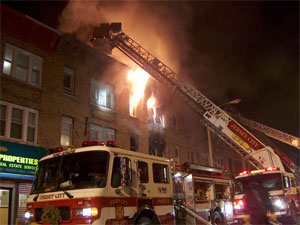MENU
Promotional Scenario & Strategy
Top scoring candidates in an assessment center will always tell you that they enhanced their oral presentation by using clarifying or “valued added statements” which indicated a knowledge base beyond the basics. As an assessor, students that exhibit these type qualities also display a measurable responsibility that all test examiners look for in a candidate’s performance; their knowledge, skills and abilities.
Whether you are preparing for upcoming company officer or chief officer exam, it is critical toward your score that you display these type qualities. You have to remember that this is a test, not an actual incident. Your ability to show confidence, conviction and clarity with an oral response will be directly related to your knowledge of the test subject areas.
 As a student testing for a company officer position, we often remind the candidates of their need to be well versed in the task areas of responsibility for the position. In a strategy and tactics assessment exercise, we mean such areas as “how do you attack, vent, and search” at an emergency incident. One common area of responsibility for the company officer is the Hoseline Selection, Stretch and Placement questions. We often see these type questions, and for valid reason.
As a student testing for a company officer position, we often remind the candidates of their need to be well versed in the task areas of responsibility for the position. In a strategy and tactics assessment exercise, we mean such areas as “how do you attack, vent, and search” at an emergency incident. One common area of responsibility for the company officer is the Hoseline Selection, Stretch and Placement questions. We often see these type questions, and for valid reason.
With that being said, how do you exhibit a knowledge base beyond the simple and basic response? Simply stating you would select a 1-3/4 inch hoseline to attack the fire in your exercise is not enough. It is not enough if you want to successfully compete in the oral assessment game. You need to go beyond and use clarifying, valued added statements to gain points toward your score. Review the following.
Scenario(s): You have two scenarios to consider. The first has you responding as the first arriving engine company operating at the scene of a private dwelling fire. The second scenario has you responding as the first arriving engine company and operating at the scene of a commercial building fire. Your question for both scenarios is:
What size hose-line will you choose to attack a fire offensively in the exercise described? Be prepared to justify the reasons for your selection.
That’s it!
Now your probably saying, I need more information.
You’re not going to get any … we want you to “think” and answer the above.
Consider the following to help build upon a future answer/response.
1-3/4 inch hoseline: This size hoseline is primarily used for residential building fires. Fires that involve room and contents within a private dwelling or a multiple dwelling will generally require the use of the 1-3/4 inch hoseline. But stating, or just using that rational is not enough. Assessors will often want the candidate to justify or clarify his or her actions. Specifically, why did you choose this size hoseline? Consider the following as a guide: (Acronym: COLS)
- Compartmentized areas/rooms generally associated with a private or multiple dwelling. (Large square footage homes may alter this thought)
- Occupant life hazard and the need to get water on the fire ASAP.
- Low to Moderate Fire Load generally associated with residential structures.
- Speed and Mobility associated with the stretch of that particular size hoseline.
2-1/2 inch hoseline: This size hoseline is primarily chosen for commercial building fires, as well as for fires that involve residential and commercial office high rises. We have noted in a previous text, that some departments will have the option of using a 1-3/4 or 2 inch hoseline in a Class/Type 1 residential high-rise housing project. This type of occupancy has a design that may allow a smaller more maneuverable hoseline. However, for the purposes of this text and exercise, we will categorize the 2-1/2 inch hoseline for fires that involve commercial structures and high rise fires. The following are justifications for 2-1/2 inch hoseline selection. (Acronym: POLLS FD)
- Volume, Reach and Penetration capabilities of a larger stream.
- Large, Open floor spaces combined with high ceilings will allow for uninterrupted fire spread.
- The Firefighter Life Hazard – Large buildings can produce overwhelming fire conditions in a short amount of time.
- Heavy Fire Load generally associated with commercial occupancies.
- The Building’s Square Footage.
- Less Friction loss associated with the 2-1/2 inch hoseline.
- Defensive stream option/capability of the 2-1/2 hoseline.
The decision on whether to use a 1-3/4 or 2-/2 hose line will be based on the scenario and its size-up factors. Factors such as the building’s construction, square footage, occupancy content, building setback, and the life hazard profile are just some of the size-up factors that may be present within a scenario which could influence hose line selection.
For structural firefighting, research shows that for most departments across the country, hoseline selection options will generally be between the 1-3/4 inch hoseline and 2-1/2 inch hoseline. Some departments have eliminated both size hoselines and chosen a 2-inch hoseline as the only option. Each size hoseline has its own limitations as well as capabilities, and it is important for a candidate to be able to identify and justify for an assessor why he or she is choosing the size line for the exercise/scenario they are confronted with.
